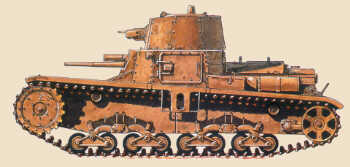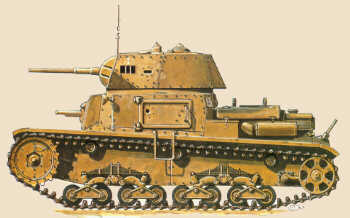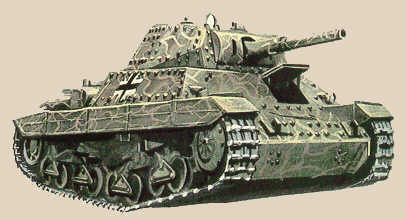A Collection of data on armoured vehicles of the Axis forces.
From 1933 a new generation of armoured vehicles was developed at Ansaldo (an arsenal and heavy industry company located in Genoa) : the “Carro Veloce CV33” (Fast Tank CV33) followed, two years later, by the “Carro Veloce CV35”. These “tanks” (it would be more appropriate to call them “tankettes”, as they were an improved version of the Vickers-Carden-Loyd Mk VI tankette ) were developed in different variants : flame-thrower, bridge carrier tank, command tank.
 Carro Veloce 35 (L/3 35) |
CV 33 (L3/33) Weight : 2.7 ton Dimensions :3.03 x 1.40 x 1.20 mt Armor (max) : 12 mm Range : 110 km Speed (max – route) : 42 km/hr Weapons : n.1 MG 6.5 mm Crew : 2 |
CV 35 (L3/35) Weight : 3.3 ton Dimensions :3.15 x 1.40 x 1.28 mt Armor (max) : 13 mm Range : 150 km Speed (max – route) : 42 km/hr Weapons : n.2 6.5 mm MG Crew : 2 |
The L.3 tanks saw action during the Ethiopian War (1935) and the Spanish Civil War (1936-39).
While the Abyssian campaign benchmark, in spite of a severe handicap given the machine guns’ narrow traverse capability, had demonstrated the L.3 sufficient reliability as infantry support tanks, even on impervious and mountainous terrain, the Guadalajara event, during the Spanish War, represented a real “fiasco” for the Italian tank units (the “Corpo Truppe Volontarie” or “CTV”, supporting General Franco’s Nationalists).
The failure can be, however, attributed mainly to the following reasons :
- the Italian armored force were inadequate, being limited to only four tank companies and one armored car company
- heavy rains precluded the possibility of providing adequate air protection to the tanks
- the L.3‘s narrow tracks were totally unreliable on soft and muddy soil
- the Russian T-26 tanks, supporting the Republican troops’ counterattack, were superior to the Italian tanks in terms of both gunnery (45 mm gun + 2 MG 7.62 mm) and armor (25mm)
The Spanish Civil War represented, however, a sort of “rehersal” of what was to happen in the forthcoming….
World War II (1940-1945)
When WWII was ignited, the three Armored Divisions (“Ariete”, “Centauro”, and “Littorio”), the Italian Tank Corps backbone, totalled less than 2.000 L.3(both /33 and /35 model) light (very light!) tanks and nearly 70 M.11/39 medium tanks.
The L.3 tanks were employed on various battlefronts : Greece, Albania, some early North African campaigns but, as they proved to be a real death trap in case of fighting with the more heavy and modern British tanks, they were withdrawn at the end of 1941.
The M.11/39 was developed as an infantry support tank. In total, between 1937 (when the prototype was ready) and 1940 (when it was replaced by theM.13/40) 92 (ninety-two) units were produced.
 |
M.11/39 Weight : 11.0 ton Dimensions : 4.74 x 2.17 x 2.25 mt Armor (max) : 30 mm Range : 200 km Speed (max – route) : 33 km/hr Weapons : n.1 gun 37 mm + n.2 8.0 mm MG Crew : 3 |
They were used as medium tanks, a task far beyond their capacities (due to their modest armor, light and narrow traverse gunnery, small road wheels and narrow tracks), during the early fightings in Lybia and had no chance against the British Matilda and Valentine.
The drawbacks of the M.11/39 led to the decision of producing a new tank which, carrying over some features of the previous design (diesel engine, transmission and road wheels), could eliminate the previous tank’s main defects. The new tank, produced by Ansaldo Fossati in Genoa, was the M.13/40, immediately followed by its improved variant, the M.14/41.
 |
M.13/40 Weight : 14.0 ton Dimensions : 4.92 x 2.20 x 2.37 mt Armor (max) : 40 mm Range : 200 km Speed (max – route) : 32 km/hr Weapons : n.1 gun 47 mm + n.4 8.0 mm MG Crew : 4 |
 |
M.14/41 Weight : 14.0 ton Dimensions : 4.92 x 2.20 x 2.37 mt Armor (max) : 40 mm Range : 200 km Speed (max – route) : 32 km/hr Weapons : n.1 gun 47 mm + n.4 8.0 mm MG Crew : 4 |
Both M.13/40 and M.14/41 proved to be much more serviceable tanks, especially as the 47 mm anti-tank gun was an excellent weapon. In total about 2,000 units were produced.
These tanks (“The” WWII Italian tanks) were widely used in North Africa and deserved enemy’s respect (the British and Australian often employed captured examples).
In 1940, in addition to the aforementioned medium M.13/40, Italy developed also a new light tank, the L6/40, specially destined to reconnaissance tasks.
 |
L6/40 Weight : 6.8 ton Dimensions : 3.80 x 1.80 x 2.17 mt Armor (max) : 15 mm Range : 200 km Speed (max – route) : 42 km/hr Weapons : n.1 gun 20 mm + n.1 8.0 mm MG Crew : 2 |
During 1942 a (supposed) improved design was the M.15/42
 |
Weight : 15.5 ton Dimensions : 5.04 x 2.23 x 2.39 mt Armor (max) : 50 mm Range : 220 km Speed (max – route) : 40 km/hr Weapons : n.1 gun 47 mm + n.4 8.0 mm MG Crew : 4 |
The improvements (thicker armor, petrol engine) were not, however, sufficient to give the Italian tanks the same features of their likely opponents (which now included also the American M3-Lee/Grant and the M4 Sherman with their 75 mm guns). The M.15/42 were shot-lived as the production ceased after the first 82 units.
The Italian Army could have had a better chance, had the P.40 heavy tank entered in service.
 |
Weight : 26.0 ton Dimensions : 5.80 x 2.80 x 2.52 mt Armor (max) : 60 mm Range : 150 km Speed (max – route) :35 km/hr Weapons : n.1 gun 75 mm + n.1 8.0 mm MG Crew : 4 |
This tank, potentially capable to peer the M3 and M4, never saw action (under the Italian colors). One prototype only was delivered, while about 200 were confiscated by the Germans directly at the Ordnance Repository in Turin after the armistice (September 8, 1943) and employed by the Wehrmacht.
Whereas the Italian tanks never had the possibility to perform at the same standards of their opponents, better proves were given by the Semoventi (self-propelled guns or SPG), often derived from the existing tank hulls. Among the others, the best weapons in this category were :
 SPG with 75/18 gun
SPG with 75/18 gun
 SPG with 90/53 gun
SPG with 90/53 gun
 SPG with 105/25 gun
SPG with 105/25 gun
Related articles
- Russian WWII Enthusiast Builds His Very Own Armored Division (warhistoryonline.com)
- Fight time! Top Ten Tanks of WWII… (warhistoryonline.com)
- The German Tank Problem (mattdickenson.com)
Nice write up!
cheers
Kevin I have a great book on this subject called “Iron Arm: The Mechanization of Mussolini’s Army, 1920-40” that is worth a read. Their industry just never had a chance fielding a mechanized army. Just like Australia.
douche